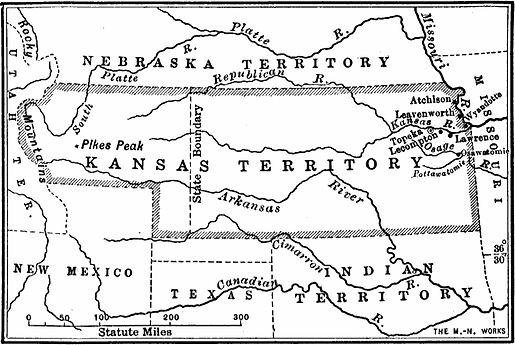THE WATKINS MUSEUM OF HISTORY
temporary exhibit...
H

KEEPING WARM
IN 1850's
Kansas Territory.
About the Exhibit
By the end of December 1855, Lawrence had been founded for barely a year. The conflict known as the “Wakarusa War” early that month had brought nearly 2,200 Kansas and Missouri men to Lawrence and the surrounded area, in the first of many battles over whether Kansas would or would not have slavery, known today as “Bleeding Kansas.” The Wakarusa War ended by mid December 1855, but the following winter would pose one of the coldest and most snow ridden of the entire time Kansas was a territory.
To stay warm during this frigid season, these men would have took advantage of the winter-ware available to them at the time. Wool drawers, undershirts, and overcoats were just some of the garments used by men during the period to stay comfortable in the cold. Retail stores in Lawrence such as the store of L. Bullene (Weavers, today) would have had avaliable similar types of clothing to Kansas men living in and visiting Lawrence during and after the Wakarusa War.
All of the clothing on display is typical of what men wore in Kansas and around the United States in the mid 1850’s, when Kansas was being founded as a US Territory.

1: “Ready-made” Overcoat in a Frock Coat Style, Faded Black, Wool with Horn Buttons, mid-Late 1850’s. C013
2: Winter Cap, Wool, 1850’s-1860’s. A017
3: Complete Mid 1850’s Men’s Suit. Consists of:
-Frock Coat, identified to a Daniel U. Smith, who wore this coat at his winter wedding on January 1st, 1853, Wool with Alpaca lining and Silk Covered Buttons, 1852-3. C018L
-Pleated Shirt, White, Linen w/ Pearl Buttons, Early-Mid 1850’s. S034
-Waistcoat, Black, Silk and Cotton, 1850’s. VS024
-Trousers, Black, Wool, cotton, and linen, 1850’s. P001/T.1.W
-Cravat or Necktie, Black and Violet, Embroidered Silk, 1840’s-1850’s.
-Suits like this were worn daily by many men in the United States, even in Kansas Territory. Tailors making bespoke garments and merchants selling ‘ready-made’ clothing were the main ways men sourced their wardrobes.
4: Top Hat, Black, Brushed Silk Plush, Paper, with Leather Sweatband, 1850’s. A025
5: Overcoat in a Sack Coat Style, Black, Wool, Cotton, with Velvet Collar, Early 1860’s. C017
6: Jacquard Woven Shawl, Paisley, Wool and Silk, 1850’s.
7: Waistcoat, Black, Wool and Cotton, 1850’s. VW002
8: Waistcoat, Black and Blue, Silk Brocade and Cotton, Early 1850’s. VB006
9: Waistcoat, Dark Brown, Wool Velveteen and Cotton, 1850’s. VV005
These artifacts are just four of several recovered from the undersea wreckage of the SS Central America, which sank September 12th, 1857.
10: Undershirt made by now famous Brooks Brothers of NY, White, Wool Knit and Cotton, 1857. S028
11: Detachable Shirt Collar, White, Linen, 1857. A008
12: Cravat or Necktie, Black and Gold Striped, Silk, 1857. A011
13: Pleated Shirt, White, Linen, 1857. S024
14: Hand-knit Drawers, White, Wool Yarn and Cotton, 1850’s-1860’s. D001
-Worn as an underwear layer, these drawers were almost certainly made to be worn during the winter months. Would you wear a pair of these to stay warm today?
15: Hand-knit Suspenders or ‘Braces’, White, Cotton, 1850’s-1870’s. A006
16: Pocket Handkerchiefs.
-Red, Faded Black, & White, Printed Cotton, Mid-19th Century. A001
-Blue, Yellow, Black, & White, Damascus Silk, 1850’s. A016
17: “Working” Cap, Black & Gold, Wool with Gold Gilt Binding, 1860’s. A014
& Ambrotype (photograph on glass) showing two unidentified men wearing cold weather shawls, the man on the left wearing a similar cap to the above, 1850’s.
-In a time where hats and caps were worn daily, caps like these were popular among men doing work where a hat brim would be in their way. How often do you wear hats?
18: Top Hat made by C. Henderson of Philadelphia, Size No. 6, Black with Brown, Green, White, & Bronze Striped Liner, Silk Plush, Paper, Silk, with Reeded Leather Sweatband, 1850’s.
19: Men’s Rubber Shoe made by the New England Rubber Company, Black, Vulcanized Rubber, Mid-Late 1850’s.
-Vulcanized rubber clothing such as raincoats, shoes, and hats were very popular among Kansans in the 1850’s. Not only could rubber keep you dry, but it acts as a great insulator in the cold.
20: Men’s ‘Fusee’ Pocket Watch, Coin Silver, Gold, Porcelain, and Glass, 1842.
& Eyeglasses with Sliding Temples, Brass and Glass, 1850’s.
21: Assortment of ‘India Rubber’ Buttons and Comb, Black, Rubber, 1850’s-1860’s.
-Like an early plastic, hard rubber was used to make everything from combs & buttons to photograph cases, pocket mirrors, and more. By the late 1850’s, hard rubber and ‘gutta-percha’ accessories could be found on many garments and in many pockets all over the US.
PLEASE CONSIDER DONATING!
Our exhibits are made possible through the generous support of people like you. If you enjoyed this display and wish to support us in our mission, please consider making a donation to The Merchant Tailor Museum. To make an even bigger impact, make us a regular part of your annual charitable contributions. Our work would not be possible without your support! Thank you!





